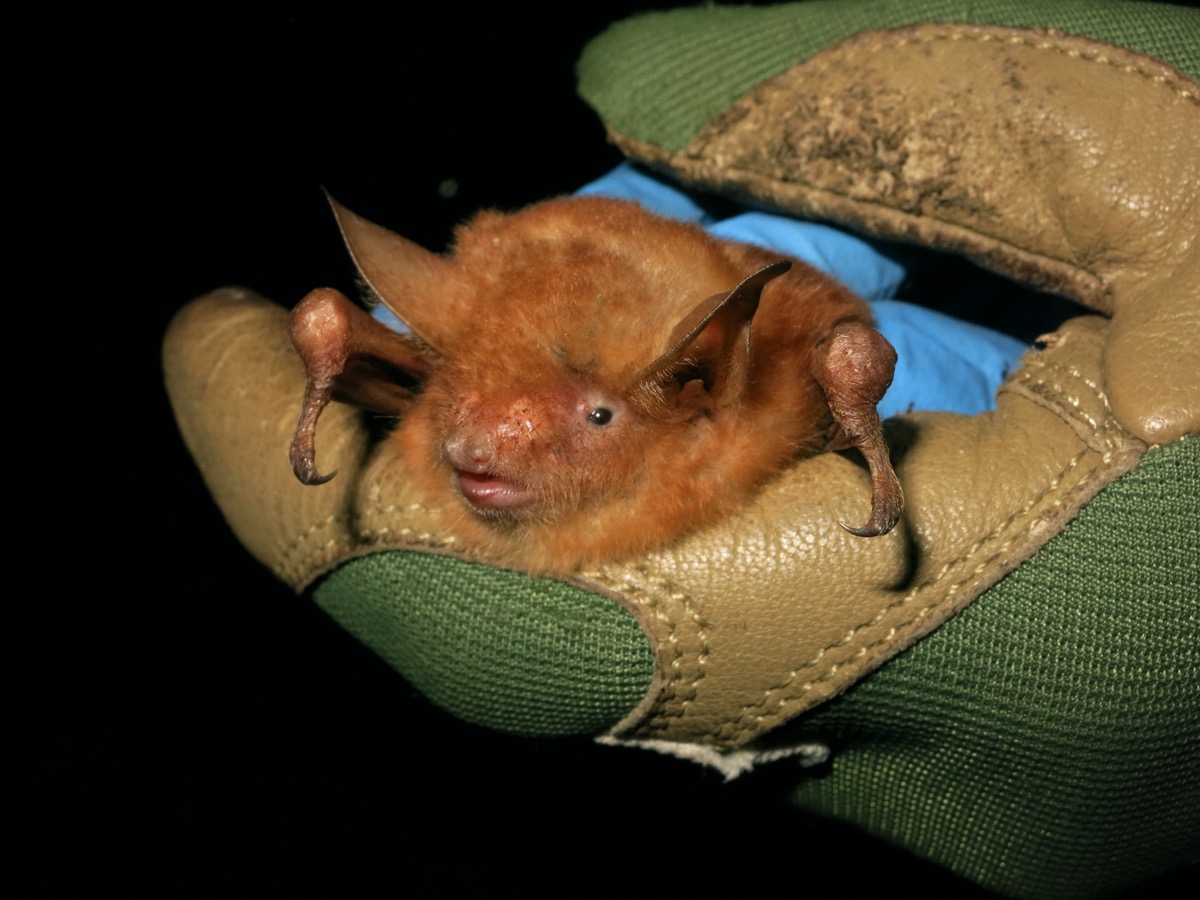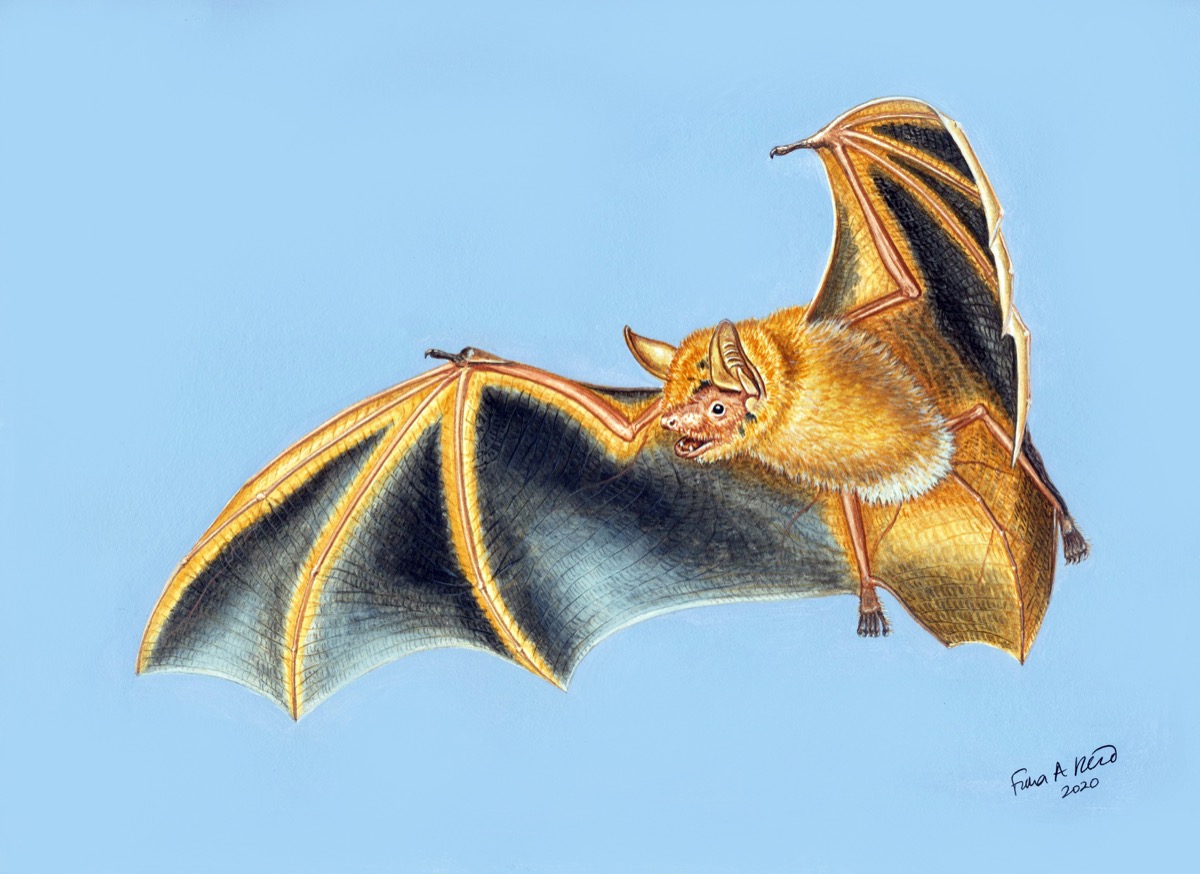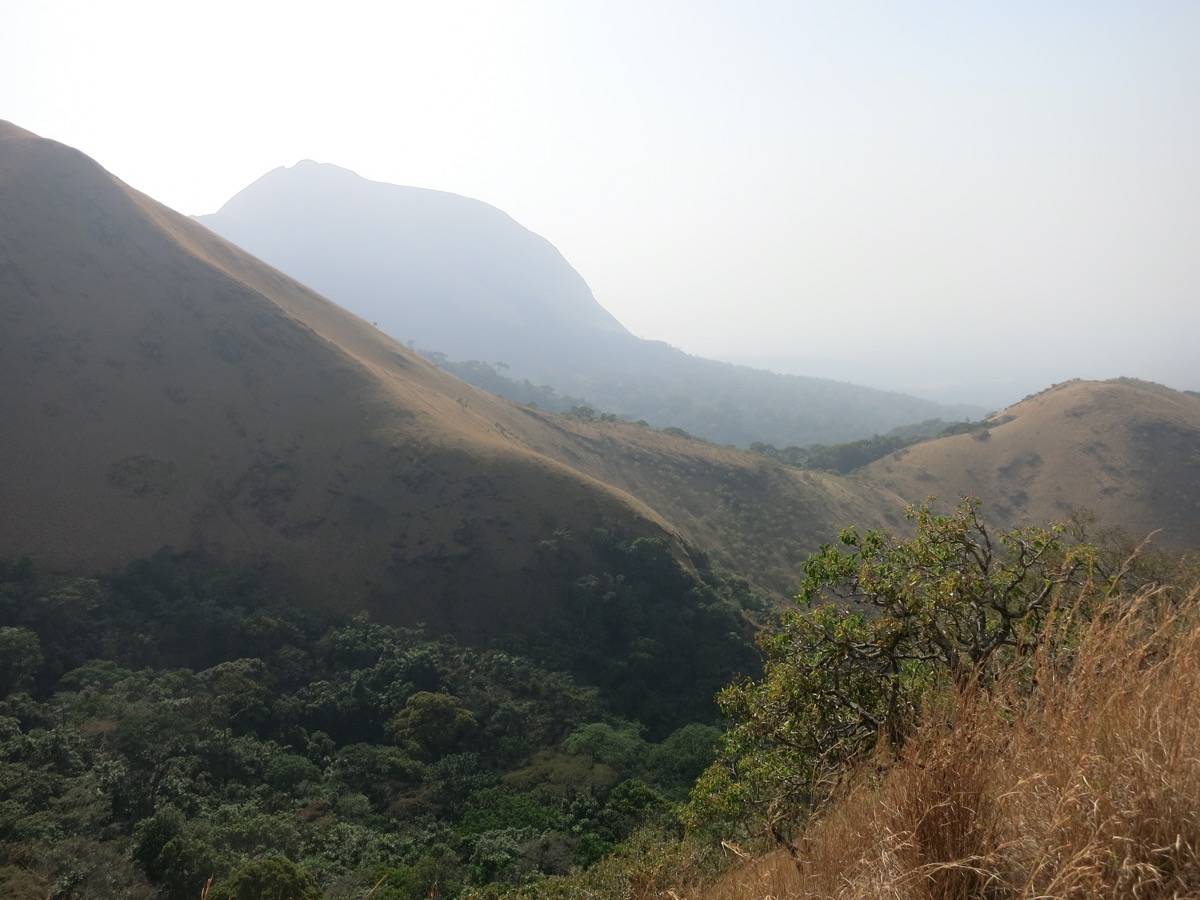Orange Is The New Black—For Bats
12:10 minutes

If you ask someone to draw a bat, they’ll probably sketch an oval body, two pointy ears, and angular wings. And chances are good your bat-artist would color the bat black.
But for a newly-described bat from West Africa, dubbed Myotis nimbaensis (mouse-eared bat from the Nimba Mountains), scientists are reaching for a different part of the color wheel. While Myotis does have some black on its body, the overwhelming majority of the bat’s fur is bright orange.

A team of scientists from the American Museum of Natural History and Bat Conservation International stumbled on the new species while surveying populations of another endangered bat in the Nimba Mountains. It lives in abandoned mine tunnels in the northern part of the mountain range. As those aging tunnels are beginning to collapse, the researchers are working to build new bat-tunnels to help preserve the threatened species.
Winifred Frick, chief scientist of Bat Conservation International, joins SciFri director Charles Bergquist to discuss the new species, and what’s being done to help protect it.

Invest in quality science journalism by making a donation to Science Friday.
Winifred Frick is chief scientist for Bat Conservation International and an associate research professor at the University of California, Santa Cruz in Santa Cruz, California.
IRA FLATOW: This is Science Friday. I’m Ira Flatow. If I ask someone to draw a bat, they’ll probably sketch, what, an oval body, two largest pointy ears, angular wings. And the color, most likely, black, maybe dark gray or brown. But a newly described bat from West Africa has scientists reaching for a different color. SciFri Charles Bergquist has more.
CHARLES BERGQUIST: Its name is Myotis nimbaensis, meaning mouse-eared bat from the Nimba Mountains, the mountain range in West Africa where it lives. And its color, it has some black, but what really stands out is its fluffy, bright orange fur. Think of the hockey mascot Gritty with wings.
The bat was recently described by scientists from the American Museum of Natural History and Bat Conservation International, and one of them joins me today. Dr. Winifred Frick, Chief Scientist at Bat Conservation International and an Associate Research Professor at the University of California, Santa Cruz.
Welcome back to Science Friday, Dr. Frick.
WINIFRED FRICK: Thank you. It’s lovely to be here.
CHARLES BERGQUIST: I’m going to encourage everyone to go to our website to see pictures of this at ScienceFriday.com/orangebat. But for the radio world, describe this bat for us.
WINIFRED FRICK: Well, it’s just spectacular looking. It’s bright orange fur. And its wings, when you open them up, are black with a contrasting orange along the finger bones in the wings. And it has a few freckles on its face and fairly large ears. And it fits about in the palm of your hand. It’s about 15 to 17 grams, so sort of average size for a bat.
CHARLES BERGQUIST: The pictures are really striking, and, as they say, no filter. Those are accurate? It looks like that?
WINIFRED FRICK: Yeah. Yeah, no, exactly. Yeah, and there’s no filter on any of those photos. We’re scientists, not artists. The animals do the art for us.
CHARLES BERGQUIST: So tell me how your team came across this bat.
WINIFRED FRICK: Well, we were part of a collaborative team working on bat conservation in the Nimba Mountains, which is an isolated mountain range in West Africa on the border of Guinea, Liberia, and Cote d’Ivoire. And the Nimba Mountains are an incredible place for biodiversity, because it’s one of these African sky islands where you have a steep mountain range that erupts from a lowland habitat. And so you have a lot of different species that are endemic, so only occur there in the Nimba Mountains.
And they’re known as a hot spot for bat biodiversity. There’s over 50 different species of bats that have been found in the Nimba Mountains. And to put that into context, that’s more species that occur in the US and Canada combined. So we were there working to assess the species that live in these old abandoned mine tunnels that were dug in the 1970s and 1980s.
And there’s a critically endangered bat called Lamotte’s roundleaf bat that lives in the tunnels, so we were trapping bats exiting these underground old abandoned mines. And this bat that we had never seen before flew into our harp trap. And like we were just talking about, it’s bright orange. It looks really different from anything else. And we knew right away that it was something really special and something that was very different.
CHARLES BERGQUIST: So you were just surveying the tunnels and stumbled on it. It wasn’t that somebody in the area said, hey, you’ve got to check out the orange ones that we know live over here?
WINIFRED FRICK: That’s right. Yeah, so we were there looking to see what species of bats were using the tunnels to assess their habitat and work on bat conservation. And we had no idea that these mountains were also this really special home to this new species that no scientist had captured before.
CHARLES BERGQUIST: Does the orange color mean anything? Or is it just we live in a world that has both golden retrievers and black labs, and this bat just happens to be orange?
WINIFRED FRICK: Yeah, so it’s interesting, the Myotis, which is the genus that it’s in, is actually one of the most species diverse genera in bats. There’s about 120 different Myotis species around the world, although on continental Africa, there’s actually relatively few Myotis. There’s only about 11 species of Myotis. And some of them have this really bright orange fur.
Why is a good question. We have a species, the Eastern red bat, here in North America that also has a bright orange fur, and that species likes to roost in trees. And so we often think, well, it probably has to do with camouflage.
But Myotis nimbaensis roosts in caves and mines, so they’re roosting in subterranean features. So it doesn’t seem like the orange pelage would be related to camouflage for roosting in trees in these species. So I don’t know why they’re orange. Good question.
CHARLES BERGQUIST: So sometimes in nature, bright colors means I’m poisonous, don’t eat me. There’s no sign of anything like that here, a warning of some kind to a potential predator?
WINIFRED FRICK: No, I don’t think so. No.
CHARLES BERGQUIST: OK. So these bats eat insects?
WINIFRED FRICK: Yep. They’re insectivorous. We really don’t know anything about their diet. The Nimba Mountains, they’re a steep mountain range. And at the top of the mountain there’s a grassland savanna-type habitat. There’s these valleys with a moist woodland that drapes the steep hills.
And it’s right at the interface, that ecotone between the savanna habitat and this moist forest habitat. And so likely, that’s where they’re foraging. Bats tend to like edge habitats, because that’s a good place to find insects. But there’s still lots to learn about this bat and what it likes to eat and more about its ecology.
CHARLES BERGQUIST: How widespread is this species? If you went to, say, the next ridge over, would you expect to find them there too?
WINIFRED FRICK: As far as we know, they may only exist here in the Nimba Mountains. This is a mountain range that’s 40 kilometers long. The Lamotte’s roundleaf bat is only known to occur in that one mountain range. And so it’s possible that it is also endemic to the Nimba Mountains.
We have been doing some acoustic monitoring where we put out sensors that record the echolocation calls of the bats. And we were able to record the call, and we know that they’re occurring in a number of the different abandoned mining tunnels. But just how widespread it is throughout the Nimba mountains, it’s notable that other bat researchers had done extensive bat surveys in the southern part of the mountain range and never encountered it. So it may be restricted not just to the Nimba Mountains, but to this northern high elevation habitat within the Nimba Mountains.
CHARLES BERGQUIST: So tell me more about what’s going on in the area. Are there threats to this bat?
WINIFRED FRICK: Yeah, so we are working with the local mining company to actually design and build new tunnels that can be put in places that will be protected and offer long-lasting habitat for these bats. The tunnels that they’re in are collapsing. So we have visited there in 2018 and then again in 2019. And in between those two field visits, one of the tunnels that had a pretty large population of Guinean horseshoe bats had collapsed. So it’s really important to be working on protecting the habitat– part of the Nimba Mountains is a World Heritage Site– and then be thinking about safe roosting habitats for these species that really depend on them.
CHARLES BERGQUIST: These are living in human-made tunnels that didn’t exist before the 1970s. Where did they come from? Where did they live before that?
WINIFRED FRICK: Well, there are some natural rock features in the Nimba Mountains that they probably were using. And there are also caves lower down. But the caves that are in the lowland habitat and in the lower part of the Nimba Mountains are under a lot of pressure from deforestation and a lot of human pressure. It’s a highly disturbed, degraded habitat. Pretty much all of the lowland habitat has been degraded or destroyed.
And so these high elevation areas and these old mining tunnels, even though they’re human-made structures, they really do represent the safest and most protected areas for some of these rare bats. They’re up in an area that the habitat’s relatively protected, and they just provide a really nice, safe habitat. But they’re collapsing, and so that’s why it’s really important for us to be working with the mining company to actually design and put in new tunnels that aren’t 40 years old and starting to collapse.
CHARLES BERGQUIST: So these would be new tunnels that are just for the bats. They’re not mining tunnels. They’re bat tunnels.
WINIFRED FRICK: That’s correct. Yes.
CHARLES BERGQUIST: Cool. How do you work to protect something that you don’t really know that much about yet? I mean, how do you decide the right style of tunnel to build for these things or the right conditions that they’re going to be most favorable?
WINIFRED FRICK: Yeah, I mean, that is a challenge. Because these tunnels are really fragile, we’re actually not allowed to go in them either. So we actually went back a year later, and we brought a little mini robot that we would send down into the tunnels that could measure the temperature, and humidity, and some of the structural complexity of the tunnel so that we have as much information as possible as we think about designing new tunnels.
And we have to use our best judgment. And we know a lot about, just generally, the kinds of features and conditions that are subterranean roosting. And these tunnels are used by a number of different species. So even though we don’t know that much yet about Myotis nimbaensis, the fact that we captured it where other bats are using these tunnels, we’re using all of that information to try to make our most informed guess.
CHARLES BERGQUIST: What would you most want to learn about this specific bat beyond saying, oh, wow, cool, orange? What do you want to know?
WINIFRED FRICK: I would love to be able to follow one of these on its nightly foraging, just from a pure curiosity standpoint of knowing when it leaves this tunnel how does it spend its night? Where does it go? What does it forage? What does it eat?
From a conservation perspective, there’s real value in knowing how big an area these bats need, what are the primary habitats that it’s foraging in, what are its primary prey species, and then how dependent is it on different kinds of features for roosting. When we think about conservation, we got to be thinking about all– food, shelter, and water are the things that bats need, and making sure that bats have those key components and that they’re protected in a landscape that allows for them to persist.
CHARLES BERGQUIST: What’s it like to add a completely new mammal into the books? I mean, that seems like it must be a thrill.
WINIFRED FRICK: It’s a dream. It’s really indescribable. Having the privilege of the opportunity to get to travel to a place like the Nimba Mountains and work alongside folks like our colleague Dr. Eric Bakwo Fils from Cameroon and be able to participate in work that is trying to protect bats in such a spectacular part of the world, it really is a dream come true and very humbling, as well, of just I see it as a privilege, and an opportunity, and something I never thought I would get to do. And certainly, yeah, stumbling across a species never described before, it’s just fantastic.
CHARLES BERGQUIST: Well, congratulations. And thank you so much for taking time to talk with me today.
WINIFRED FRICK: Well, my pleasure. Thank you so much.
CHARLES BERGQUIST: Dr. Winifred Frick is Chief Scientist at Bat Conservation International and an Associate Research Professor at the University of California, Santa Cruz. And you can see pictures of this bat on our website at ScienceFriday.com/orangebat. For Science Friday, I’m Charles Bergquist.
Copyright © 2021 Science Friday Initiative. All rights reserved. Science Friday transcripts are produced on a tight deadline by 3Play Media. Fidelity to the original aired/published audio or video file might vary, and text might be updated or amended in the future. For the authoritative record of Science Friday’s programming, please visit the original aired/published recording. For terms of use and more information, visit our policies pages at http://www.sciencefriday.com/about/policies/
As Science Friday’s director and senior producer, Charles Bergquist channels the chaos of a live production studio into something sounding like a radio program. Favorite topics include planetary sciences, chemistry, materials, and shiny things with blinking lights.